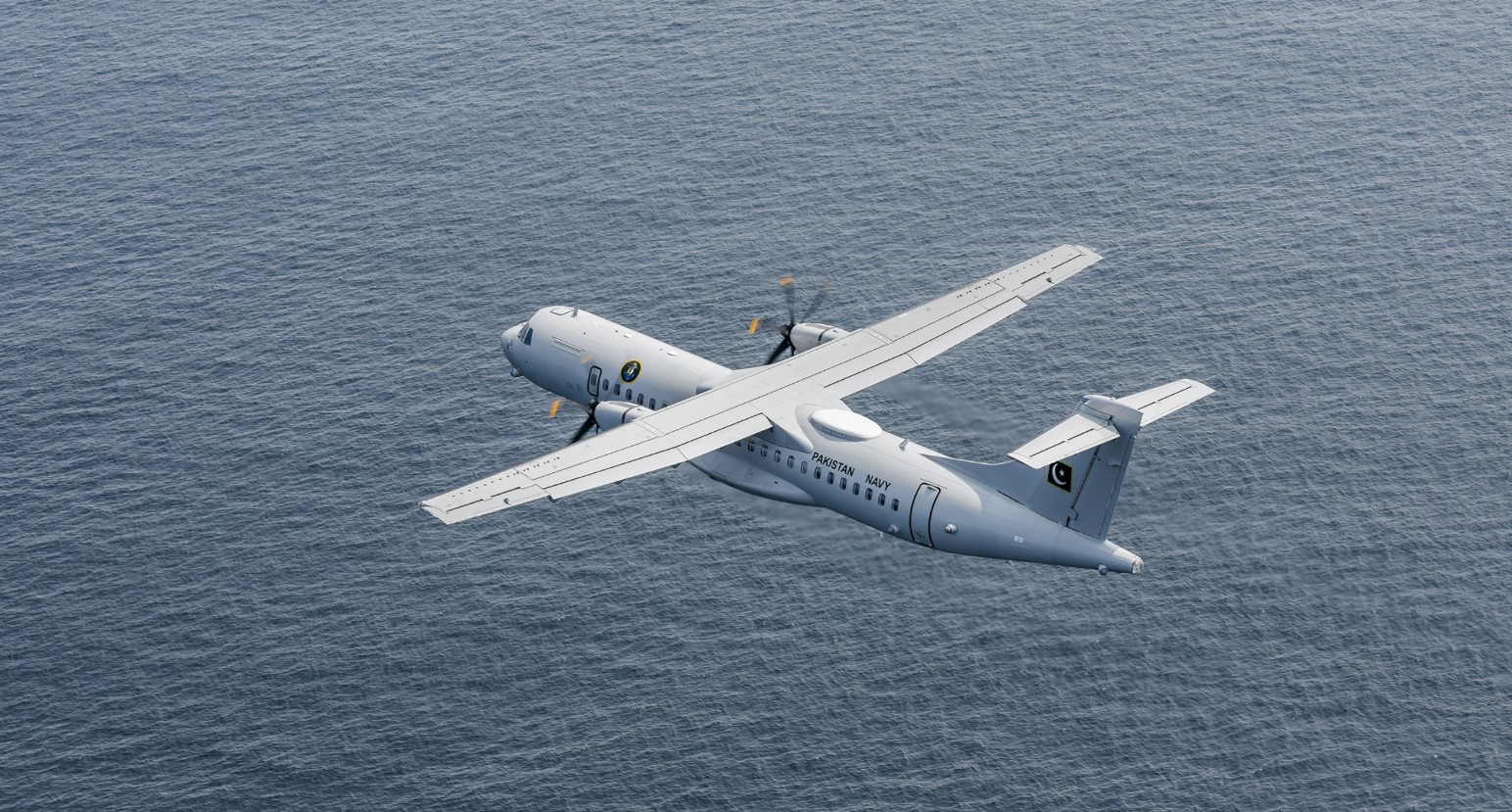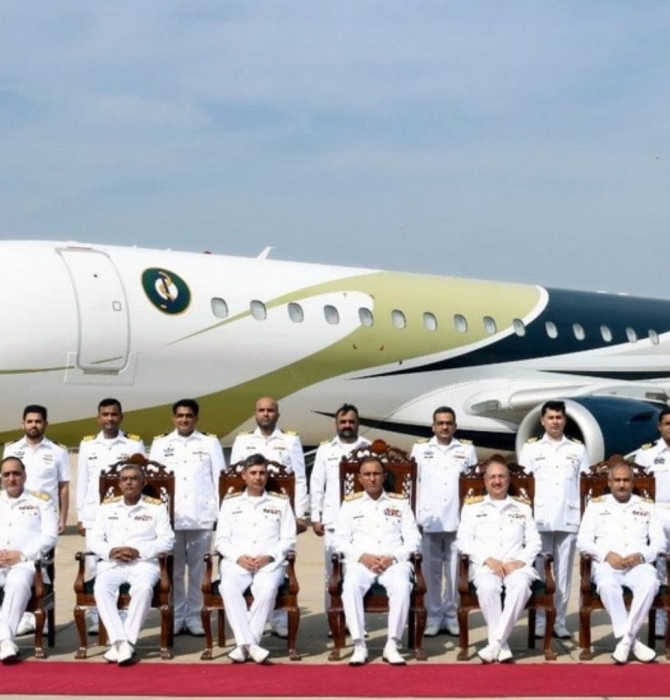2999Views 0Comments

ATR-72 Maritime Patrol Aircraft (MPA)
The RAS-72 Sea Eagle is among the Pakistan Navy’s (PN) newer inductions. The RAS-72 is a maritime patrol aircraft (MPA) based on the ATR-72, a commercially available commuter aircraft. The PN initiated the RAS-72 MPA program in 2016 by contracting a German aircraft maintenance, repair, and overhaul company – Rheinland Air Service (RAS) GmbH – to carry out the integration and testing work.
It seems that the PN ordered the RAS-72 to replace its Fokker F27s. Compared to such a predecessor, the RAS-72 is a significant capability upgrade. The RAS-72 consists of a new-generation subsystem and sensor suite. Moreover, unlike the Fokker F27, the RAS-72 can also carry torpedoes and anti-ship missiles.
Currently, the PN operates two RAS-72s, with a third aircraft on order.[1] According to the main contractor, Rheinland Air Service (RAS), the PN planned to acquire a total of four RAS-72s.[2]
Background: ATR-72
The ATR-72 is a twin-engine turboprop commuter aircraft. It is manufactured by ATR, a joint venture led by Airbus and Leonardo (which both absorbed the original French and Italian companies involved in ATR).
The ATR-72 was based on the ATR-42, itself a popular commuter aircraft. Since its first flight in 1988, ATR delivered over 1,000 ATR-72s to regional airlines in Asia, Western Europe, and Latin America. Following its commercial success, a number of countries sought the ATR-72 for military purposes.
Leonardo, one of ATR’s principal backers, offers an MPA version of the ATR-72 – i.e., ATR-72MP/P-72. But Leonardo does not hold a monopoly on customizing the ATR-72; smaller companies – such as RAS GmbH – have also configured the aircraft for military roles. The RAS-72 is one such example.
Pakistan Navy Seeks Platform for Long-Range Anti-Sub Warfare Aircraft | In January 2020, the Pakistan Navy (PN) released a tender for one twin-engine jet-powered aircraft intended for conversion into a long-range maritime patrol aircraft (LRMPA)… | Read More
The Pakistan Navy’s RAS-72 Sea Eagle
The PN contracted RAS GmbH to configure two ATR-72s into MPAs in 2015, with RAS GmbH starting the work on the first aircraft in 2016.[3][4] The PN received its first RAS-72 MPA in July 2018, and formally inducted that same aircraft in December 2018. It inducted the second RAS-72 in January 2020. The third aircraft is undergoing the conversion process at RAS GmbH’s facility in Mönchengladbach. Currently, the PN intends to acquire four RAS-72 MPAs, ostensibly to replace its Fokker F27s.
The PN selected the ATR-72-500 to serve as the basis for its RAS-72s. However, the PN opted to configure its aircraft’s Pratt & Whitney Canada PW127F turboprop engine to the level of the PW127M. The engines offer an output of 2,750 shp. In other words, the PN’s ATR-72-500 is similar to the ATR-72-600.[5]
Specifications
The following specifications are from RAS.[6]
- Length: 27.17 m
- Height: (With Vertical Stabilizer): 7.65 m
- Wingspan: 27.17 m
- Maximum Cruise Speed: 465 km/h
- Service Ceiling: 25,000 ft
- Endurance: 9+ hours
- Maximum Take-Off Weight (MTOW): 23,000 kg
In addition, RAS says it can configure the RAS-72 with four external hardpoints – two at the front of the fuselage, and two at the rear. The two front hardpoints can carry lightweight torpedoes, while the two rear hardpoints can support lightweight anti-ship missiles. Thus, in addition to maritime surveillance, the RAS-72 is capable of both anti-submarine warfare (ASW) and anti-ship warfare (AShW).[7] However, the PN version appears to be equipped with only the two ASW hardpoints.[8]
Subsystems
The RAS-72 almost entirely comprises of commercially off-the-shelf (COTS) subsystems. Its electronics are largely from a number of European Union (EU) states, namely Italy, the United Kingdom, and Germany.
Active Electronically Scanned Array (AESA) Radar
The RAS-72 uses the Leonardo Seaspray 7300E as its main surface surveillance and targeting radar.[9] The Seaspray 7300E is an X-Band AESA radar. The exact specifications of the Seaspray 7300E are not available, but its capabilities likely hover between those of the Seaspray 7000E and Seaspray 7500E.
In terms of range, the Seaspray 7300E would have a maximum coverage between 200 nautical miles and 320 nautical miles (i.e., 370 km to 593 km). It also has a synthetic aperture radar (SAR) mode and provide high-resolution images of land. Thus, it can support surveillance operations over sea and land.
Electro-Optical and Infrared (EO/IR) Turret
Being one of the RAS-72’s US-origin subsystems, the FLIR Systems Star SAFIRE III is an electro-optical and infrared (EO/IR) turret.[10] The Star SAFIRE III provides the RAS-72 aircrew with the capability to survey areas using imaging/video feeds, and in multiple modes (e.g., thermal, low-light, etc). The Star SAFIRE III could also operate as a target laser-designator, which (in theory) would allow the RAS-72 to deploy laser-guided air-to-ground missiles (AGM) such as the AGM-114 Hellfire, UMTAS/OMTAS, and others.
Electronic Support Measures (ESM)
The RAS-72’s ESM suite comprises of electronic intelligence (ELINT) equipment as well as a defensive aide system (DAS). The ELINT and DAS are both supplied by Elettronica. The DAS likely includes a radar warning receiver (RWR), laser-warning receiver (LWR), and a chaff/flare system.[11] It is not known if the DAS comes with an electronic countermeasure (ECM) suite (which would allow the RAS-72 to mitigate enemy radars and radar-seekers). The specifics of the ELINT suite are also not known, but it likely offers the ability to monitor and record radar emissions (and build an electronic warfare threat library). The ELINT suite uses reportedly 10 antennas configured to both sides of the fuselage.[12]
(Report) The MILGEM Jinnah-Class Frigate: Pakistan’s Next Generation Warship? | On 05 July 2018, the Pakistan Ministry of Defence Production (MoDP) signed a deal with Turkey’s Military Factory and Shipyard Corporation (ASFAT A.Ş.) for four MILGEM warships for the Pakistan Navy (PN)… | Read More
Mission Management System
The RAS-72 uses Aerodata AG’s AeroMission mission management system. The AeroMission suite can link to each of the RAS-72’s sensors to present a concise image of the situation to the operator. This is a critical advantage for the RAS-72 as it draws on multiple types of advanced sensors – such as its AESA radar, the ELINT suite, and EO/IR turret – to support its ISR functions. The RAS-72 houses for consoles in its cabin.[13]
Tactical Data Link System
The PN’s RAS-72 will reportedly use “Link Green,” a tactical data link (TDL) protocol/system indigenously developed by Pakistan.[14] As with other Link Green platforms, one can assume that the RAS-72 will be able to exchange and receive data with the Naval Information Exchange System (NIXS). In theory, this enables the RAS-72 to provide situational awareness and targeting support to the PN’s Azmat-class missile-armed fast-attack crafts (FAC-M), allowing the latter to fully use their long-range anti-ship missiles.
Satellite Communication (SATCOM) System
The PN reportedly fitted its RAS-72s with a satellite communication (SATCOM) suite consisting of Ku-band terminals.[15] This would make sense because Pakistan’s PakSat-1R is equipped with Ku-band transponders. SATCOM will enable the RAS-72s to communicate and transfer sensor feeds data at beyond-line-of-sight (BLoS) range, which would also point to integration with NIXS (which also uses SATCOM).
Weapon Systems
The PN got its RAS-72s configured for ASW. Its aircraft are equipped with two hardpoints that can support lightweight ASW torpedoes. As noted earlier, the RAS-72 is reportedly capable – technically speaking – of carrying two additional hardpoints and anti-ship missiles.
However, at this time, the PN opted to limit the RAS-72 to ASW operations, and even then, ASW is not the main purpose of these aircraft in the PN. Rather, it seems the PN will primarily use the aircraft for ISR and search-and-rescue (SAR), though the MPAs can take on ASW if required. But it seems the PN is looking to build upon its airborne ASW and AShW through its next-generation jet-powered MPA.
Pakistan Navy’s Plans for the RAS-72 Sea Eagle
Currently, the PN is focused on acquiring four RAS-72s. It has inducted two aircraft, and it has a third unit undergoing conversion in Germany. It is not known if the PN will order additional aircraft, especially as it has a jet-powered long-range maritime patrol aircraft (LRMPA) program in the pipeline.
For More Information and Insights on the Pakistan Navy, See:
- Pakistan Navy Chief Outlines Aviation Modernization Plans
- Analysis: Pakistan’s Efforts to Pair Eastern and Western Solutions
- Pakistan Navy Tests Dual Land-Attack and Anti-Ship Cruising Missile
[1] Alan Warnes. Twitter. 27 June 2020: https://twitter.com/warnesyworld/status/1276950924406161410
[2] İbrahim Sünnetci. “Meltem-3 Project & ATR-72/600 Turkish Maritime Patrol Aircraft – Comparison of Pakistan and Italian Maritime Patrol Aircraft!.” Defence Turkey. 2020. Issue 99. Volume 14.
[3] Ralf Jüngermann. “Airport: Major order from Pakistan.” Rheinische Post. 21 May 2016. URL: https://rp-online.de/nrw/staedte/moenchengladbach/flughafen-grossauftrag-aus-pakistan_aid-19682309
[4] Ibid.
[5] İbrahim Sünnetci. “Meltem-3 Project & ATR-72/600 Turkish Maritime Patrol Aircraft – Comparison of Pakistan and Italian Maritime Patrol Aircraft!.” Defence Turkey. 2020. Issue 99. Volume 14.
[6] Product Profile. RAS-72 Multi-Role Aircraft. Rheinland Air Service. URL: https://specialmission.ras.de/the-ras72/
[7] İbrahim Sünnetci. “Meltem-3 Project & ATR-72/600 Turkish Maritime Patrol Aircraft – Comparison of Pakistan and Italian Maritime Patrol Aircraft!.” Defence Turkey. 2020. Issue 99. Volume 14.
[8] Product Profile. RAS-72 Multi-Role Aircraft. Rheinland Air Service. URL: https://specialmission.ras.de/the-ras72/
[9] Alan Warnes. “Pakistan Navy ATR72MPA to fly in October.” Warnesy’s World. 28 June 2017. URL: http://warnesysworld.com/pakistan-navy-atr72mpa-fly-october/
[10] Ibid.
[11] Ibid.
[12] İbrahim Sünnetci. “Meltem-3 Project & ATR-72/600 Turkish Maritime Patrol Aircraft – Comparison of Pakistan and Italian Maritime Patrol Aircraft!.” Defence Turkey. 2020. Issue 99. Volume 14.
[13] Ibid.
[14] Ibid.
[15] Ibid.

